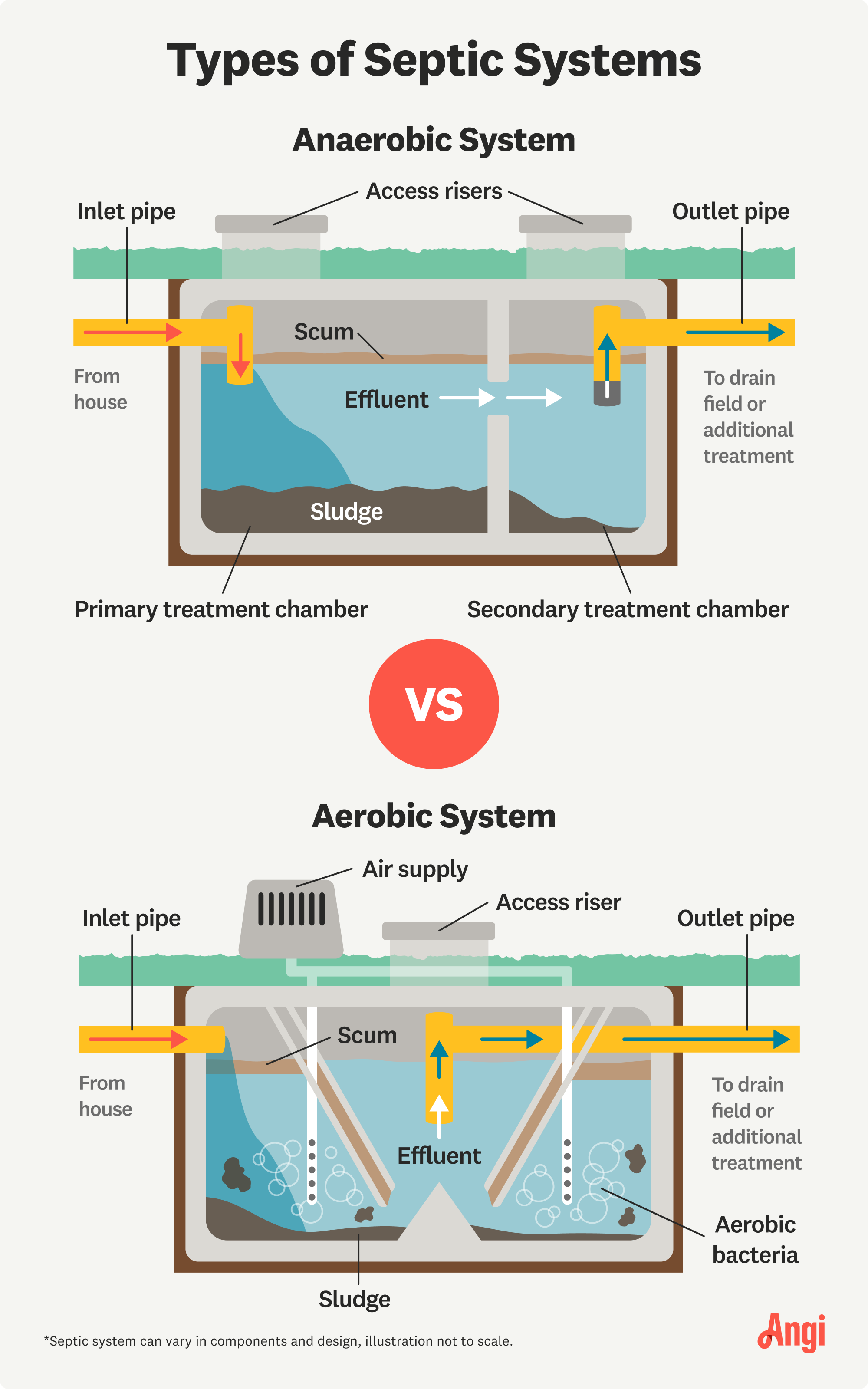
Concrete is one of the longest-lasting septic tank materials. Find out concrete septic tank prices for your wastewater management project.
Septic tank service costs depend on your project and location. Check with a local pro for your specific job.
Florida has several septic system regulations to protect groundwater from pollution.
The average Orlando home with three or four bedrooms needs a 1,000-gallon septic tank.
Concrete tanks are the most common option, but fiberglass could help prevent algae growth.
A failing septic system can reduce home value and make it more difficult to sell your house.
The cost to install a septic system in Orlando is $4,717 on average, with most homeowners spending anywhere from $3,225 to $6,635. About a third of homes in Florida use septic systems, and Orlando is no exception. Though there are unique regulations to protect the groundwater that most of Florida uses as drinking water, the actual installation remains affordable compared to other major cities. Here’s how the major cost factors will influence your project.
The cost of installing a septic tank in Orlando, Florida, depends on various factors, such as the size of the tank, the material, the labor, and your proximity to specific bodies of water.
Orlando has minimum and maximum septic tank requirements based on the estimated amount of waste your home will produce. The septic tank size correlates with the number of bedrooms in your home.
A three- or four-bedroom home needs a 1,200-gallon septic tank, which costs about $900 to $3,000 for the tank alone.
As tank size increases, so do costs. Smaller septic tanks cost less, but larger houses need larger systems because they have more sinks, toilets, bathtubs, and other wastewater sources that flow into the septic tank.
| Tank Size (Gallons) | Number of Bedrooms | Average Cost (Tank Only) |
|---|---|---|
| 1,000 | 1–2 | $600–$1,500 |
| 1,200 | 3–4 | $900–$3,000 |
| 1,500 | 5–6 | $1,200–$4,000 |
| 2,000 | 7+ | $1,500–$5,000 |
Septic tanks are commonly made of plastic, concrete, or fiberglass. Concrete is the most common option in Florida, but choosing another material can have benefits. Here’s how much a tank costs to install based on each material.
| Septic Tank Material | Average Cost | Pros | Cons |
|---|---|---|---|
| Concrete | $3,500–$7,000 | Highly durable with the longest lifespan | Can crack over time |
| Plastic | $2,000–$5,000 | Lighter, easier to install, and budget-friendly | Lowest durability |
| Fiberglass | $3,000–$6,500 | Easy to install and resists cracking, corrosion, and algae growth | Higher cost |

There are two main types of septic systems, each with its own set of pros and cons. While anaerobic systems are relatively low-maintenance, they aren’t great for small properties. Similarly, anaerobic systems can do well in small spaces but require extra work.
| Anaerobic | Aerobic |
|---|---|
| Anaerobic bacteria break down waste | Aerobic bacteria break down waste |
| More affordable | More expensive |
| Uses fewer chemicals | More efficient |
| Needs a larger leach field | Good for smaller properties |
Anaerobic: Anaerobic systems are more common and cost $2,000–$7,000. They’re less costly than aerobic systems and don’t need extra power or chemicals, but they’re less efficient and require a larger leach field. A pipe runs from the house to the septic tank, where another pipe runs into the leach field. Anaerobic bacteria break down solid waste before the system distributes the wastewater into the soil.
Aerobic: Aerobic septic systems utilize oxygen pumped into the tank to activate bacteria that feed on the solid waste. They’re more expensive at $8,000–$15,000 but are more efficient and work well on smaller properties. They require additional power to run, so hook yours up to a power generator in case of a power outage. Otherwise, these systems can plug into your property’s main power source.
If you live in the designated “Priority Focus Area” of the Wekiwa River and Rock Springs area, you may need to install an enhanced minimum 65% nitrogen-reducing septic system. There are different types, but most utilize aerobic processes. These can cost $10,000 to $35,000, but you may qualify for a grant or be able to retrofit your existing setup with a pretreatment system at a lower cost.
Orlando has a unique landscape that requires certain considerations. You’ll need to account for high groundwater from the Floridan Aquifer and potential flooding from tropical storms. This requires specific site prep:
Land Survey: You’ll need to get a land survey before installing a septic system to ensure your plans fall within property lines and are located at a sufficient distance from potable groundwater, wells, pools, buildings, and storm drainage. Expect to spend $330–$900 to hire a licensed land surveyor.
Percolation Test: Before the installation, you need a local perc test pro to perform a percolation test. The test measures water drainage in the soil, soil type, and the height of each sediment layer on your property to determine the best type of septic system for you. For example, limestone soil requires special considerations. The cost to test your soil is $700–$2,000.
Leach Field Installation: Septic tank systems consist of a septic tank and a trench referred to as a leach field or drain field. This section of the system transports the wastewater back to the soil. Drain field installation costs an average of $5,000–$12,000. Costs could exceed this range for alternative systems, like mound systems or nitrogen-reducing systems.
Labor makes up around 40% of the cost of a septic system installation in Orlando, Florida. The cost of living is more affordable than in other areas, so labor costs are slightly less expensive than the national average. Here’s a closer look at labor and permit costs for this project.
A local septic system company will charge around $1,500 to $3,000 for labor. Septic tank installation is performed by a Master Septic Tank Contractor who is licensed and registered by the Florida Department of Environmental Protection. However, licensed plumbers often work on septic tank problems.
A permit to build a septic system in Orlando costs $425 and ensures that your installation meets local septic system regulations. Florida’s main source of drinking water is groundwater, and each county has its own regulations meant to protect it. In Orlando, the permitting process is overseen by the Florida Department of Health’s Orange County office.
A working and well-maintained septic system won’t increase or decrease your home value. That said, you may have trouble selling your home at the full value if:
Your septic system is failing
You live in the Priority Focus Area and need to upgrade your system
If you notice problems with your septic system, it’s a good idea to call an Orlando septic system pro to address the issue before it spirals into a more expensive fix. A failing septic system can make or break a home sale. If the cost of septic tank repairs is similar to a replacement, you may want a new septic system altogether.
Pumping your septic tank every three to five years is one of the most important septic maintenance tasks. When you combine that with flushing only approved items (toilet paper and waste) and avoiding driving over your drain field, you have a recipe for a long-lasting septic system.
Home is the most important place on earth, which is why Angi has helped more than 150 million homeowners transform their houses into homes they adore. To help homeowners with their next project, Angi provides readers with the most accurate cost data and upholds strict editorial standards. We survey real Angi customers about their project costs to develop the pricing data you see, so you can make the best decisions for you and your home. We pair this data with research from reputable sources, including the U.S. Bureau of Labor Statistics, academic journals, market studies, and interviews with industry experts—all to ensure our prices reflect real-world projects.
Want to help us improve our cost data? Send us a recent project quote to [email protected]. Quotes and personal information will not be shared publicly.
From average costs to expert advice, get all the answers you need to get your job done.

Concrete is one of the longest-lasting septic tank materials. Find out concrete septic tank prices for your wastewater management project.

Need to know what sewer line replacement costs in Austin, TX? This guide will help you prepare to budget for sewer line replacement done by local contractors.

Need to know what sewer line replacement costs in Charlotte, NC? This guide will help you prepare to budget for sewer line replacement done by local contractors.

Cleaning out clogged or dirty septic field lines is a quick job for a seasoned pro. Learn what makes up the total cost to clean septic field lines

Knowing your septic tank’s location can help you prepare for maintenance, renovations, and more. For tips on how to find a septic tank, check out this guide.

High utility bills are often a sign of trouble. If you’re wondering, “Why is my sewer bill so high?” review this guide for potential causes and fixes.